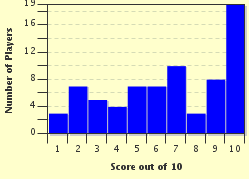Quiz Answer Key and Fun Facts
1. The Tokugawa clan apparently took its name from the village of Tokugawa in the Kozuke province in the thirteenth century, though they didn't rule the shogunate until 1600. Here we see their "mon", or family crest, which is a familiar sight in Japan symbolizing shogunate power. What is the pattern of the mon called?
2. Pictured is a battle between two daimyo, or clan leaders, in 1561. Between the fourteenth and sixteenth centuries, Japan's main leader was an emperor, but the position was mostly ceremonial. The shogunate was the main source of power keeping the daimyo, or minor leaders, together. However, many daimyo began to challenge the shogun. What was this war-torn time known as?
3. The daimyo were at war with each other, and in some cases at war with the shogunate itself. Before the Tokogawa took power, the many clans needed to be reunited under one rule. A common saying at the time referring to Japan's unification was "____________ pounds the national cake, Toyotomi Hideyoshi kneads it, and Tokugawa Iesayu sits down and eats it." Who was the powerful leader who united many of the clans of Japan, allowing for his ally, the Tokogawa clan, to rule?
4. This folding screen depicts many daimyo pledging allegiance to the Tokugawa shogunate at their ruling castle. Previously, the ruling authority and power was based in Kyoto, but the Tokugawa moved the center of the shogunate's power to a small fishing village, which after a name change, is the current Japanese capital city. Where was the new center of power?
5. Social stratification became less pronounced during the Tokugawa Shogunate and there was more opportunity to advance from one's low class in society to a higher class.
6. Pictured is a Japanese red-seal ship, which was an armed merchant ship based upon the design of European galleons. They traveled the seas of Asia on merchant trips, as well as defending against piracy. The first European trade ship arrived from Portugal and the Europeans began trading with these red-seal ships within their Asian colonies. Most often associated with the firearms and Christianity they imported into the country, what were the European traders called?
7. The Tokugawa Shogunate utilized the "metsuke" (shown here in Japanese) to help keep the peace in their lands. These well-trained officials were primarily responsible for which of the following?
8. The third Tokugawa shogun, Iemitsu, began to meddle significantly in the affairs of the daimyo, shuffling them around, splitting territories, and removing some altogether. As a result, many of the samurai who served under the former daimyo often became leaderless and jobless. As seen in this image, these wandering samurai were angered by this meddling and began the Keain Uprising to push out the shogunate. What were they called?
9. For nearly 200 years, the Tokugawa shogunate instituted the policy of "sakoku" in which foreigners were not allowed to enter the country under penalty of death. There were small exceptions, but the shogunate wished to stem the influence of the Europeans and dash any colonial aspirations. What event shown in the illustration forcibly ended this policy of "sakoku" in 1853?
10. Discontent over shogunate weakness and the decision to relent to foreign powers led to the Satsuma clan and its allies to begin a campaign on behalf of the emperor to bring him back to power. This photograph shows the generals plotting to overthrow the shogunate. Since the Tokugawa began their rule, they had made the role of emperor a powerless one. However, this uprising succeeded in overthrowing the last shogun, Tokugawa Yoshinobu, who the generals feared as being a strong leader. What was the name of this Japanese civil war?
Source: Author
trident
This quiz was reviewed by FunTrivia editor
bloomsby before going online.
Any errors found in FunTrivia content are routinely corrected through our feedback system.

